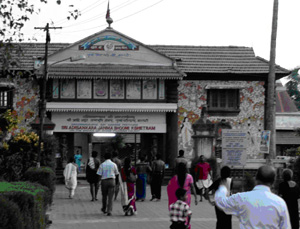First report from IndiaBy Kenneth Zysk
I arrived in India early morning on 13 January 2007. The air was a balmy 25º, but not heavy with humidity, as this is considered to be the cool and dry season in the southern state of Tamilnadu. The drive to the former French colony of Pondicherry took two-and- half hours until I reached the front gate of the colonial style French Institute of Indian Studies on Rue Saint Louis. The French Institute will be hosting me for the period of my research on the traditional Indian medicine surrounding Tranquebar. The room provided me in the guest-house is Spartan, but is equipped with warm water, a working air conditioner, and most importantly, a DSL line to connect to the internet.
After a brief rest, later that morning I was introduced to the head of team working on Siddha medicine in southern India, Dr. Brigitte Sebastia, with whom I had am immediate rapport. Dr. Sebastia is a middle-aged lady, who left her position as a chemist in a biological laboratory in France to return to school for doctorial studies, and has been doing post-doctorial work at the Institute for the past several years. She is accompanied by her husband Christian, who is retired. As a team, she, doing the field work, and he, doing the photography, the two Sabastias have managed to produce a rich storehouse of documentation on Siddha medicine and medical practice in Tamilnadu in the form of interviews, films, and photographs, which they have kindly put at my disposal.
Two days after my arrival in Pondicherry, I travelled to Kerala on the west coast of southern India, where I presented a paper at the “International Seminar on the Textual Tradition of Ayurveda” in the small village of Kalady, famous for the birthplace of the famous Indian philosopher, Sankaracarya. We were hosted by the Shree Sankaracarya University of Sanskrit and were house in the Guest House of the monastery of the Hindu temple devoted to Sankaracarya, deemed to be “the holiest place in the world”.
While attending the seminar, which lasted a full five days, I was able to meet and speak with a remarkable group of healers who belong to the caste of Nambudiri Brahmins and are skilled in the treatment of snake bites and poisons. They belong to the tradition of Vishavaidya or “Poison-doctors,” which has a textual tradition in Sanskrit attached to it. Although the texts of the tradition are very recent, dating from about the 17th century A.D., the epistemological basis of the system is purely Ayurveda and the medicines include alchemical preparations similar to those found in Siddha medicine. This remarkable fact indicates that Vishavaidya, in Kerala, like Siddha medicine in Tamilnadu, was first an indigenous form of healing, transmitted from one generation of healers to the other by word of mouth, until the received the theoretical frame work of the three bodily humours or doshas, wind, bile, and phlegm, from the by then Brahminical system of Ayurveda. From about the 17th century, both Siddha medicine and Vishavaidya developed as practical tradition of healing with ongoing texts in Sanskrit, Malayalam, and Tamil in South India.
|
|

The Sankara Temple in Kalady.

"Holiest place in the world".
|